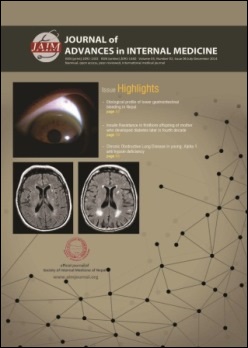Metastatic nodular pneumonia due to septic embolism: a Staphylococcal infection
DOI:
https://doi.org/10.3126/jaim.v3i2.14068Keywords:
Necrotizing pneumonia, Panton-Valentine Leukocidin, Staphylococcal pneumoniaAbstract
Ill-defined lung nodules mimicking secondary metastasis caused by Staphylococcus aureus though defined, is uncommon. We report a 58 years male with chest pain, dry cough, fever and abscess over the nape of neck. Bilateral nodules in the chest x-ray resembled metastasis. Workup for malignancy was negative. Induced sputum grew Staphylococcus aureus resistant to penicillin group. The lesions cavitated and produced air-fluid levels. Computed tomography confirmed the peripheral location, right sided hydropneumothorax and loculated fissural collection. Recovery was favourable but delayed with injectable ceftriaxone and levofloxacin initially followed by oral levofloxacin. Review chest radiograph showed residual cavities with small pneumothorax. Follow-up after three months showed resolution of all cavities and pneumothorax. Literature review revealed both Methicillin sensitive and resistant staphylococcus aureus can cause metastatic nodular pneumonia. Rapidly necrosis occurs if the organisms are capable of producing the toxin: Panton-Valentine Leukocidin. But this tendency is more common with community-acquired methicillin resistant strains.
Journal of Advances in Internal Medicine 2014;3(2):68-71
Downloads
Downloads
Published
How to Cite
Issue
Section
License
This license enables reusers to distribute, remix, adapt, and build upon the material in any medium or format, so long as attribution is given to the creator.




